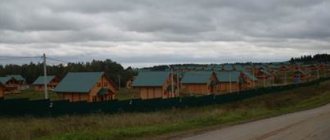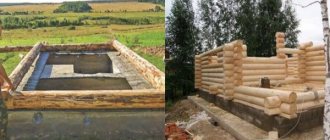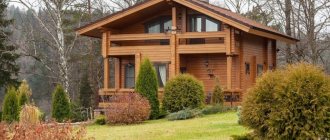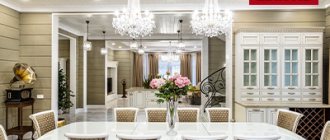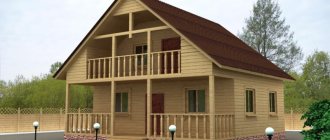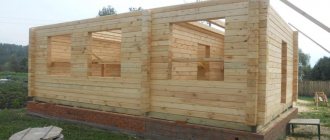Assembling a house from timber: what needs to be done before it
Houses made of timber: projects and development
Any construction must begin with the development of a project. Projects must include drawings of the future construction, as well as the materials and tools that will be used. By drawing up such a document, you can not only design a house that is suitable in all respects, but also accurately calculate the required amount of building materials and total financial costs.
In the process of drawing up a project, it is important to take into account a lot of important details, namely:
- The place where building material will be purchased, as well as where it will be stored during the construction of the house;
- What kind of communications will need to be carried out;
- Before starting construction work, you must obtain a building permit from the architectural department;
- It is also important to create a detailed estimate.
Important: When developing a project, it is necessary to take into account the dimensions of the timber used.
Budgeting
In order to calculate the total financial costs of a log house, it is customary to draw up an estimate in the form of a table. All materials and tools are included in it along with their cost. The cost of the construction work itself is also included there. Depending on the specific features and parameters of the project, the final estimate may vary greatly.
Selection of timber
When choosing a material for building a log house from timber, you need to know that there are several types of this building material:
- Ordinary timber;
- Profiled;
- Glued.
Much will directly depend on financial capabilities. Of course, it is much more convenient to use glued or profiled timber. These types of timber are almost dry and also have special groove locks. And this greatly simplifies the entire process of assembling a house.
When choosing and purchasing timber, experts recommend following the following rules:
- It is better to purchase timber made from timber harvested in winter. This is due to the fact that in this way more resin will be retained in the wood, which will increase the durability of the building material;
- When purchasing timber, it is important to have a tape measure with you to check the dimensions declared by the seller, as there are often cases when the declared dimensions differ greatly from the actual parameters of the timber;
- You should also visually examine the evenness of the material;
- You need to make sure that fungus and mold have not affected the wood in any way;
- Wood with fallen knots should be rejected.
Purchase of construction materials and tools
If you are going to build a log house from timber, you will need to purchase the following building materials:
- Wood beams;
- Insulation;
- Edged and unedged boards;
- Lumber for creating ceilings, floors and interior partitions;
- Building materials for roofing;
- Windows and door panels;
- Waterproofing;
- Construction staples;
- Nails and other consumables.
The purchase of building materials can be carried out either in stages as needed, or in full at once.
If you are going to build a house from timber with your own hands, you will need the following equipment and tools:
- Excavator for preparing the site for the foundation;
- Concrete mixer;
- Wooden formwork;
- Scaffolding and scaffolding;
- Various hand tools for woodworking and concrete work.
Depending on the type of foundation used, different types of equipment can be used.
Requirements and parameters
Wooden products classified as glued and used for the construction of a private house are manufactured and operated strictly in accordance with GOST 20850-2014, as well as 33124-2014, which refer to other documents.
These references concern the determination of the dimensions and quality of the material, requirements for use and safety in operation.
The process of producing laminated veneer lumber is multi-stage. Here the sequence of work stages according to the instructions is strictly followed :
- The prepared wood material is first dried until its moisture content is 10%.
- Then the workpieces are subjected to grinding processing - they are planed until they acquire ideal geometric shapes.
- After this, the compliance of the beams with the declared dimensions is checked. If the dimensions are not enough, then the timber is spliced and then treated with a special impregnation - protective compounds that have an antibacterial effect.
- The gluing of beam lamellas takes place under high pressure conditions using professional factory equipment.
- When working with lumber, they are often equipped with cutting joints in the form of grooves. If required by the project, then the connections made in the form of nodes are cut.
After all the work performed, you should end up with a three-layer beam made of high-quality processed, dried and glued wood. Houses with such material will meet all safety and quality standards, differing in strength and aesthetic characteristics, without deformation in shrinkage, drying out of the structure, rotting and damage from external factors (insects, fungus, rotting). In addition, glued timber is not prone to spontaneous combustion.
It was established in the laboratory that the strength characteristics of laminated veneer lumber exceed those of solid wood by almost 2.6 times, which makes it possible to erect buildings in regions with high levels of humidity.
Foundation for a house made of timber
For timber houses, foundations that are not too massive are ideal, for example:
- Tape with a shallow type of filling over the entire area and with all load-bearing walls;
- From screw piles with overlaying concrete slabs;
- Columnar type foundation followed by the use of siding for cladding.
Houses made of timber: how to assemble
Timber processing process
A log house necessarily involves treating the wood with various chemical compounds. To maximize the protection of wood from premature destruction and ignition, you must adhere to the following scheme:
- First, the wood is treated with a special antiseptic;
- Next, a fire retardant composition;
- Then light protection;
- At the very end, waterproofing is used.
Wiring a house made of timber
Anyone who is interested in the question of how to make a log house from timber with their own hands should know this. The first crown of the log house (or frame) should be laid level on the pre-dried waterproofing. It is important to remember that the first crown must have a larger cross-section than the others. In this way, the overall stability of the entire structure is achieved. The first crown must be laid on a backing board.
The wooden frame is fixed to the foundation with metal anchors. The box is attached to the foundation only if we are talking about a small building. Large houses with several floors will be stable due to their weight without additional fixation.
The walls of a timber house are built by laying alternate rows. For this reason, the main thing is to understand how the first crown is laid. All crowns and rows are fixed using a dowel.
All layers of timber alternate with tenons and grooves to achieve maximum strength and reliability of the entire structure. In addition, this allows you to make the corners of the building completely windproof. And this has a positive effect on maintaining heat indoors.
Connecting timber in corners and lengthwise
There are two ways to connect timber in the corners:
- With remainder;
• No residue.
Moreover, for each method there are several pairing options, which depend on the method of forming the angle itself.
At the same time, there are four options for longitudinal connections:
- Half a tree;
- Longitudinal tenon on dowels;
- Longitudinal root spine;
- With an oblique lock.
The longitudinal connection method using a tenon on dowels is the most reliable. Therefore, it is most widely used when building a log house from timber. In this case, the groove manufacturing technology completely repeats the technology of corner joints with keys.
We build walls
When building country houses from profiled timber, to save money, it is enough to use products with a section of 10 by 10 cm, this is enough to withstand all kinds of loads.
- The first step is to lay out one row on the base.
Concrete one reinforcement rod just above the formwork to use it to more securely fix the beams
- The next step is laying the second row of timber, fixing it along its entire length with dowels every meter.
Note! The fasteners should be recessed 1-2 cm into the material so that it does not come into contact with the timber of the next row.
- It is better to start assembling from one corner, building two perpendicular walls, not forgetting about possible internal partitions. If your project has them, then additional grooves should be made in the timber and the internal walls should be laid simultaneously with the external ones.
You will have to select the grooves manually; to do this, use a hacksaw or chainsaw
- Window openings should be left empty until the house has completely settled, with a few exceptions - one row of timber should connect all sides of the window opening. This is necessary in order to avoid unevenness. The same goes for doorways.
Window openings should look the same as in this photo
Application of dowels
If wooden dowels are used in the construction of timber buildings, it is important to make them from the same type of wood as the timber itself.
It happens that for greater reliability, the timber is tightened with metal dowels. In this case, such a solution will be significantly more expensive, which may affect the overall cost of construction.
Installation of dowels occurs by analogy with brickwork. A hole several centimeters in diameter is drilled for the pins so that they can be inserted without effort. The installation of dowels should be done at a distance of one and a half meters from each other.
How much does it cost: prices per cubic and m2
Good quality laminated veneer lumber, made in accordance with GOST, with a quality certificate costs good money. On average, in the Russian Federation the cost per 1 m3 is 25-28,000 rubles per 1 m3 . The price is influenced by the urgency of the order, seasonality (in summer the price may be higher), delivery to the location, remoteness of the facility, depreciation services, quality of drying and production of wood material.
Some manufacturers produce such high-quality timber that they have a large number of orders, and many customers even have to wait in line. The most expensive material is in St. Petersburg, Krasnoyarsk, Novosibirsk and Moscow Region, and cheaper in the central regions of Russia.
So, for example, 1 m2 of a two-story house in the Moscow region, completed on a turnkey basis, which includes all types of work from start to finish, according to the price lists provided on the official websites of companies, costs from 40,000 rubles per 1 m2. Hiring a team of workers under a contract can be cheaper and provide a guarantee. Without a contract, various difficulties may arise.
Before starting construction, it is necessary to calculate your financial capabilities, since the timber will need to be purchased with an advance payment first of all.
Caulking process
When a log house is built from glued or profiled timber, caulking is not carried out. At the same time, if we are talking about building a house from ordinary timber, you cannot do without it. Caulking is a process of insulating inter-crown joints by compacting various natural insulation materials.
The following materials are used for caulking:
- Natural moss with excellent thermal insulation properties. This material also perfectly resists the formation of fungus and mold. And this increases the service life of the building. In all respects, this material is ideal. Its only drawback is that it is very inconvenient to make caulk with its help;
- Linen tow. This material also has a number of advantages, which are completely negated by the fact that it crumbles after five years. Because of this, you have to re-caulk;
- Hemp hemp is an excellent material. It was widely used by our great-grandfathers. Its structure is very similar to natural wood;
- Jute is an imported natural material that is produced in ribbon format. It is very convenient to use, which is why it is widely used in modern construction of timber buildings;
- Linen batting is a material that is a mixture of flax and batting; its main disadvantage is its strong absorption of moisture.
Main features of the caulk:
- The process starts from the top crown moving downwards;
- First, the crown is caulked from the outside and then from the inside;
- First, rough caulking is carried out to isolate large cracks, and then cosmetic caulking is carried out to give a pleasant appearance to the seams.
Consumables and tools
When contacting a construction company, in accordance with the contract provided to the client, the estimate and the consumables themselves are provided by the company .
Sometimes this is much more profitable than buying on the retail market yourself, since companies cooperate with various industries and purchase in bulk, which means the price for the client may be lower than the market price.
When purchasing independently and building a cottage with your own hands, you will need:
- Beam of a given size (length, thickness, section diameter) in the quantity calculated according to the project + 10% reserve for unforeseen circumstances.
- Thermal insulating material (for example, roofing felt in rolls or sheets).
- Wooden boards of various sizes for auxiliary work, as well as flooring.
- Fastening elements (corners, nails, screws, dowels, studs, anchors, staples, etc.).
- Dowels (long wooden nails 22 x 22 (mm), for fixing layers to each other).
- Drills and drill, miter saw, circular or band saw, hacksaw, screwdriver, hammer, sledgehammer, chisel, plane.
- Measuring tools (tape tape, construction cord, square, plumb line, etc.).
- Rags, work clothes, industrial vacuum cleaner or cleaning items (brooms, buckets).
- Windows, doors, roofing material, devices for creating thresholds, stairs.
When purchasing material and selecting tools, you must choose a material that is not damaged, has a guarantee and a quality certificate from the manufacturers. In addition, before starting work, you should pay attention to the condition of the laminated timber - it must be perfectly dry.
Shrinkage of a timber house
The greatest shrinkage is observed near log walls. In some cases, per three meters of wall, shrinkage can reach ten centimeters. For rounded logs, the shrinkage is slightly less, it can reach eight centimeters.
Depending on the moisture content of the timber, shrinkage may vary:
- Timber with natural humidity parameters shrinks from 6 to 10 centimeters per 3 meters of wall;
- Glued laminated timber shrinks up to two centimeters.
Due to the fact that a log house made of laminated veneer lumber is characterized by minimal shrinkage, it can be finished immediately upon completion of construction work.
Flaws
It would be unfair to omit this section. However, it will be much shorter.
- The first thing you have to think about at the design stage is the price. Glued laminated timber is somewhat more expensive than profiled timber.
- The second is the need for periodic processing of wooden structures, especially from the outside, in order to extend their service life.
Let's finish here. The remaining shortcomings are not so significant and can be easily solved as they arise to focus attention on them.
Log house from timber after assembly - what needs to be done
Construction and installation of the roof
The rough roof consists of ceiling beams, sheathing and rafters, which are installed according to the project. After the walls are erected, the lags are laid. In this case, the ends of the logs should protrude half a meter from the wall.
For logs, a beam with a cross-section of 15x10 centimeters is ideal. The logs are installed on edge, at a distance of 90 centimeters from each other. At the next stage, the rafter system is installed, for which boards of 5x15 centimeters are used.
A variety of materials can be used as roofing, for example:
- Metal tiles;
- Ruberoid;
- Ondulin;
- Corrugated sheeting, etc.
Floor construction
After completing the installation process of the bottom trim, the floor joists are laid. The logs are laid on edge, after which they are covered with a subfloor, which is made from boards 2.5x15 centimeters. The finished flooring is often made from tongue and groove boards.
Installation of windows and doors
Shrinkage compensation is the most important nuance when installing windows and doors in a log house. For this reason, window frames and doors are attached to a special casing. Thermal insulation material is placed in the gap between such a box and the wall to prevent heat loss.
Insulation of the house
Such houses are distinguished by good thermal insulation, as wood retains heat well inside the room. For this reason, the entire procedure for insulating such a building comes down to high-quality caulking to eliminate all cracks.
Interior decoration of a timber house
Work on the interior decoration of the house is carried out only after it has completely settled. In general, the inside of a house made of timber can be decorated with absolutely any materials; everything will depend on the specific wishes of the owner of the house.
Eco-hut only 30 m²
mike099FORUMHOUSE user
The dream has long crept in about building a wooden house - environmentally friendly, practically without paints, mineral wool, polystyrene foam and other “benefits” of modern industry. The task is to build a solid, comfortable house with minimal effort, suitable for winter visits and year-round living, therefore shingles, boulders, mezzanines, Russian stoves and other delights of centuries past were not included in the project.
The craftsman immediately decided on the design:
- Pile foundation.
- Box made of hand-cut logs.
- Metal roofing.
- Sawdust with clay and sawdust with lime are used as insulation for floors.
Results
The process when you build a log house yourself is not something very complicated. Of course, it is advisable to have at least minimal construction experience. However, even a complete beginner can easily construct such a building.
The main thing is patience, determination, and adherence to the basic rules for building houses made of timber.
If you use high-quality building materials, and also carefully approach the smallest details, then the finished house will turn out not only beautiful and comfortable, but also durable.

